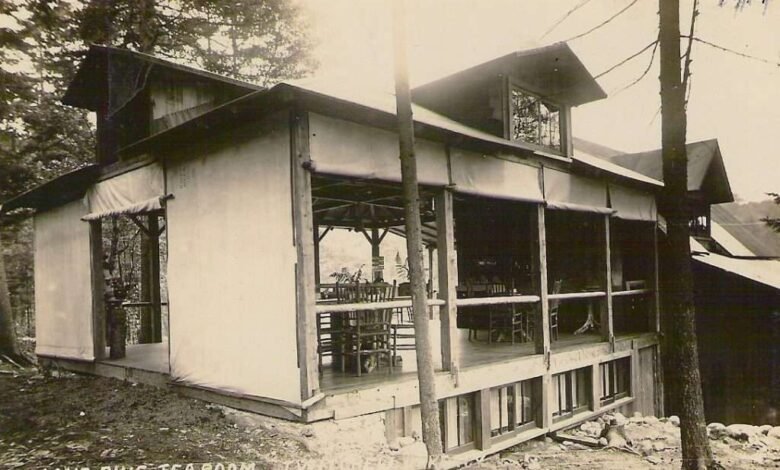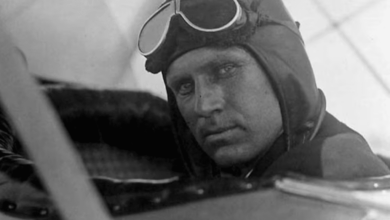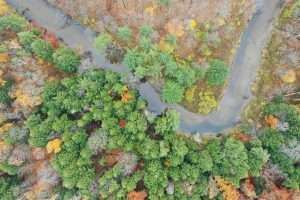An Adirondack Lake’s ‘Mayoral Couple,’ Fred & Myra Ellmers


 Fred Ellmers’ first visit to Twitchell Lake came in the summer of 1914, or a year or two earlier. His marathon train trip began in Brooklyn and ended in Big Moose, where a buckboard transported him to Twitchell’s public landing, a two-mile boat ride taking him to the dock of Lone Pine Camp on the north end of the Adirondack lake in northern Herkimer County, NY.
Fred Ellmers’ first visit to Twitchell Lake came in the summer of 1914, or a year or two earlier. His marathon train trip began in Brooklyn and ended in Big Moose, where a buckboard transported him to Twitchell’s public landing, a two-mile boat ride taking him to the dock of Lone Pine Camp on the north end of the Adirondack lake in northern Herkimer County, NY.
His first words exiting the boat, were: “This is where I could spend the rest of my life!”
His invitation came from a young businesswoman he met in a shop near his home in Brooklyn where unique mountain arts and crafts were featured and sold. Margaret Almira Hamilton (1879-1930) went by Myra, and according to The Gouverneur Free Press she made this trip after visiting her sister Laura in Belfort, NY (in the town of Croghan, Lewis County).
Myra was 35 years of age, and she made Fred’s acquaintance on one of her earlier trips to the city, an annual event. Myra and Laura were born in Cranberry Lake, in St. Lawrence County, where their father Lowell S. Hamilton (1852-1927) began his woodsman and guiding career.
On April 8, 1901, “Low” purchased a parcel of land on the north end of Twitchell Lake from Truman S. Skilton. Lone Pine Camp included sleeping rooms atop a boat house, winter quarters, camps for family groups, a shop and laundry, an ice house, and quarters for help.

 The “Tea Room” Low built afforded a beautiful lakeside view, crowning the hotel with a new name, “Lone Pine Tea Room.” The Hamilton’s served a growing clientele of repeat customers that included sportsmen and women, hunters, fishermen, and hikers.
The “Tea Room” Low built afforded a beautiful lakeside view, crowning the hotel with a new name, “Lone Pine Tea Room.” The Hamilton’s served a growing clientele of repeat customers that included sportsmen and women, hunters, fishermen, and hikers.
Low kept two tent platforms and a guide boat at Terror Lake, from which he guided parties to Single Shanty Pond, Rose Pond, and Andy’s Creek. Trails he maintained to Beaver River and Big Moose Lake’s North Bay gave access to more than a few of their customers.
Myra grew up in this remote location, long winter days and nights spent with her mother Mary Ann Brant (1859-1922) in their “winter camp” dug into the northeast side of a hill, a large open kitchen and wood fire burning in the kitchen range protecting them from winter winds.
There they crocheted doilies, crafted birch bark items and boxes made of porcupine quills and sewed balsam pillows. Myra took up the task of supervising the Tea Room kitchen and servers, the ice they harvested in early February, keeping perishable food safe all summer long. In addition, Myra ran a profitable store and souvenir shop, where her Adirondack crafts were sold.
A Lone Pine brochure Myra produced around 1909 puts her marketing and management skills on full display, the cover listing her as Lone Pine’s proprietor. The Tea Room and its menu is detailed, “a fresh supply of Huyler’s every week,” the premier producer of chocolate and cocoa at the time.

 A trail map she drew is included with all nearby trails marked. For those arriving at Big Moose Station, a telephone line called up transportation by horse and buggy, round trip fare 25c. She closed with her own Lending Library “with its 280 books of latest fiction at the disposal of the public for the small sum of 2c per day.”
A trail map she drew is included with all nearby trails marked. For those arriving at Big Moose Station, a telephone line called up transportation by horse and buggy, round trip fare 25c. She closed with her own Lending Library “with its 280 books of latest fiction at the disposal of the public for the small sum of 2c per day.”
Hired as a chore boy in the 1930s, Aziel LaFave described Myra as “a striking young lady… slender with long dark hair, which reflected her partial Mohawk Indian ancestry … a very bright young lady and clever with her hands” according to a 1988 Adirondac Magazine writer. Sparks flew between these two a good while before Fred’s first visit to Twitchell.
Their relationship flowered into a 1915 marriage, and Fred’s permanent residence at the Lone Pine Tea Room. This is what Aziel said about Fred:
“[He was] a handsome, dapper, young insurance salesman from Brooklyn. He was born of thrifty middle-class German immigrants. He was blond with a ruddy complexion, slender and medium height. He attended a private boys’ school, then took a few clerk-type jobs before going into insurance.”
Fred’s parents emigrated about ten years before he was born. They settled with thousands of other immigrants in Brooklyn, NY. Baptized as “Herman Frederick Ellmers” (1880-1969), Fred’s marriage to Myra totally changed his life.
Fred’s early days at the Lone Pine Tea Room were not easy. Low questioned how on earth he was going to teach this city slicker from Brooklyn how to cut wood with a cross-cut saw, wield an axe, and care for and harness a horse? Gradually, though, mutual respect developed and Low found it easier to tolerate his city-bred son-in-law.

 Fred’s personality won him lifelong friends, his sense of humor, wisdom, and love for people becoming legendary. Many illustrations of this followed the years Fred and Myra spent together managing the Lone Pine Tea Room, first by assisting Low and Mary Ann.
Fred’s personality won him lifelong friends, his sense of humor, wisdom, and love for people becoming legendary. Many illustrations of this followed the years Fred and Myra spent together managing the Lone Pine Tea Room, first by assisting Low and Mary Ann.
For Fred that meant meeting the train at Big Moose Station, keeping refrigerators iced, handling maintenance problems, leading canoe trips and wilderness hikes, sharing stories and songs around the campfire, and ferrying customers in the Duchess, an old passenger and freight boat about 20-feet long, covered by a very substantial wood and canvas fringed top, and powered by a gray marine engine that burned gallons of gas.
During the 1920s, Fred’s duties included caring for a new member of the hotel community named Genevieve. Genevieve loved to ride in the Duchess, spend time entertaining guests, and with some reservations, tolerated children of all ages. Genevieve was a donkey.
In the early years, Fred and Myra remained in Lone Pine for the whole winter, Myra stocking up with enough food they could survive without trips to town. One night with snow blowing and drifting deep outside, she assured him:
“[We have] a large crock of venison sausage (recipe: two-thirds venison and one-third pork), smoked ham, and a winter’s supply of potatoes and apples, not to mention many jars of home canned fruits and vegetables.”
But they did not stay holed up in camp all winter. Employing their horse and sleigh, they drove out over the ice to attend square dances, church socials, and other community events. A safe route over the lake was marked with tree branches to avoid thinner spring-fed areas camouflaged by the snow cover.
The time came when they took an annual Florida trip, but immediately the question arose, “What do we do with Genevieve?” Well, they filled her shelter next to a flowing stream with hay and said their goodbyes.

 Upon their return in spring, they approached the dock to a very loud bray. Genevieve had survived an Adirondack winter, anxious to begin a new season.
Upon their return in spring, they approached the dock to a very loud bray. Genevieve had survived an Adirondack winter, anxious to begin a new season.
Fred fulfilled two promises Low asked him to make early on, to carry on with the Lone Pine Tea Room after him, and to “carry him out feet first.” The end came for Low Hamilton June 15, 1927, after his last sickness, and with help, Fred carried his father-in-law out of Lone Pine and across the lake “feet first.”
Later, Fred reflected on what he considered to be “the greatest job in the world:
“When I used to meet people at the landing, I had a joke for them as I was loading their luggage on the Duchess; I had them laughing as we rode up the lake. Their vacation had already begun… I could give my guests two weeks of fun. They would say that those were the happiest days of their lives, and the memories of those days would last the whole year.”
Myra died in Florida after a short illness in 1930, a loss Fred never really recovered from. However, Fred did carry on the Lone Pine enterprise for over thirty years, taking on a new role that probably got him the unofficial title “Mayor of Twitchell Lake.”
Prior to 1938, camp owners had to get mail at the Big Moose post office across from the station. One morning, next-door neighbor Christine Allen came to the dock and encouraged “Freddie” to take on a mail route that would mail and deliver letters by boat. Fred was not convinced.
In two weeks, Christine returned with a letter from Eleanor Roosevelt, the President’s wife, stating that the Postmaster General of the US authorized and appointed Fred Ellmers as mail carrier. Aziel LaFave offered this touching detail in a Adirondack Express column by Ken Sprague:
“On the first day of service, the cook, the two waitresses, guests and I, the choreboy, gathered on the dock and gave him an enthusiastic send-off, complete with trumpet fanfare, this time played on a French horn.”

 Fred delivered the mail for many years, first using the Duchess, and later switching to his outboard “tin boat.” In addition to delivering the mail he often brought groceries and other items to campers. One order of milk for the Herbens fell in the lake and was later recovered and turned into cottage cheese.
Fred delivered the mail for many years, first using the Duchess, and later switching to his outboard “tin boat.” In addition to delivering the mail he often brought groceries and other items to campers. One order of milk for the Herbens fell in the lake and was later recovered and turned into cottage cheese.
Succeeding Fred on the route when he retired, were Walt Cole, Fay Brownell, Stewart Turk, and Judy Kellogg.
Even to this day, campfire storytelling will recall Fred and Myra Ellmers who loved Twitchell Lake and shared it through their beloved Lone Pine Tea Room.
Fred did remarry Elinor J. Ellmers, known for her singing voice and winter home in Rome, NY. Fred’s father’s second wife was “Eleanor M. Ellmers,” these two introducing some confusion on the family tree.
Fred died in 1969 and was memorialized by a brass plaque under the Lone Pine sign, designating Fred as “the only Mayor of Twitchell Lake.” The Kellogg family took over and carried on the legacy of Lone Pine in 1958.
Read more about Twitchell Lake and the Adirondacks.
Illustrations from above: The Lone Pine Tea Room, ca. 1915; View of Lone Pine Tea Room from the lake, ca. 1909 (Myra Hamilton Ellmers); Myra’s trail map of Twitchell Lake, Big Moose, and the surrounding area, ca. 1909; Fred Ellmers and the Duchess at the Lone Pine Tea Room, 1937; Young ladies with the Lone Pine donkey, ca. 1920; and the memorial to Fred Ellmers below the Lone Pine’s sign, 1969.
Source link




